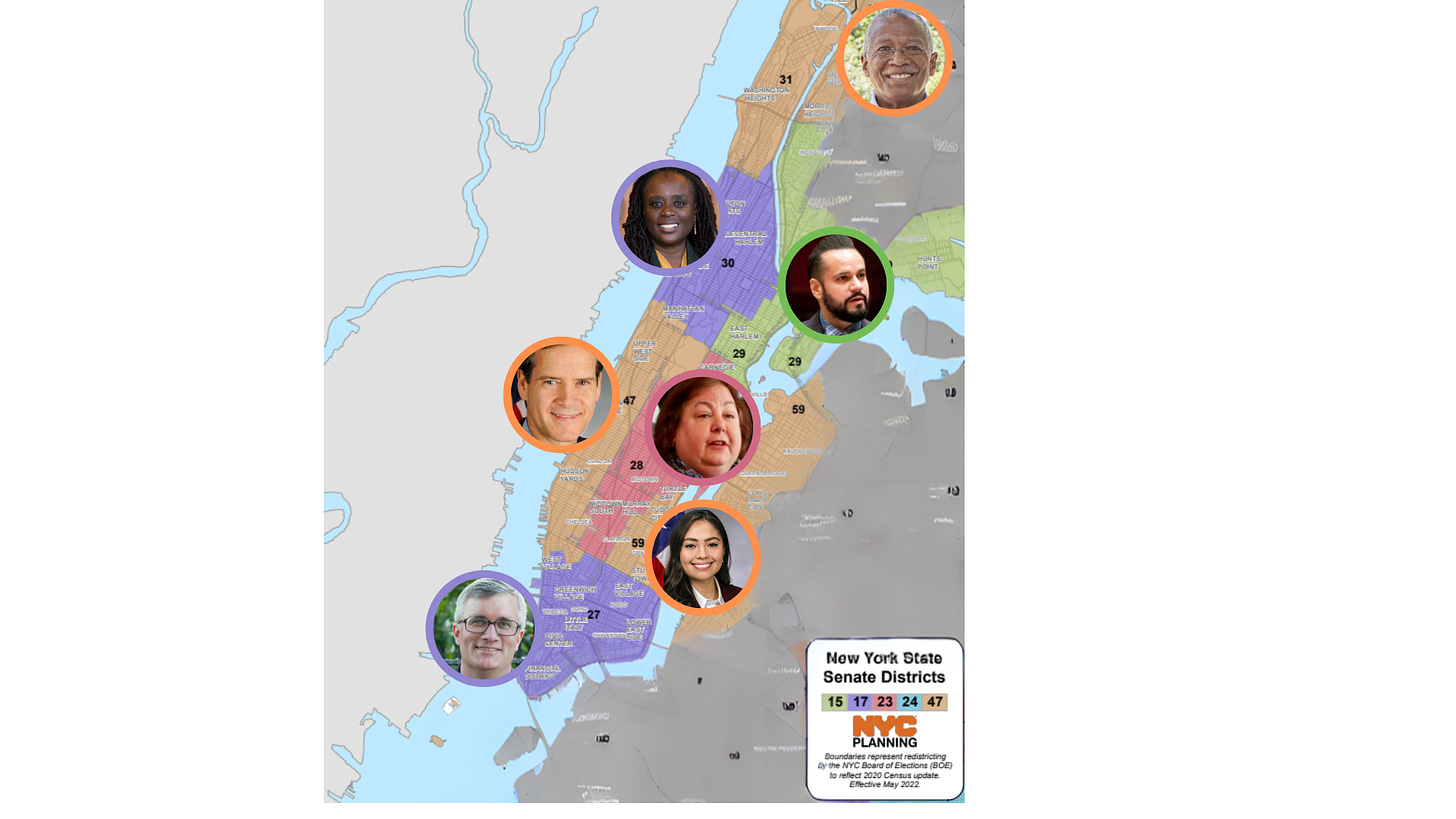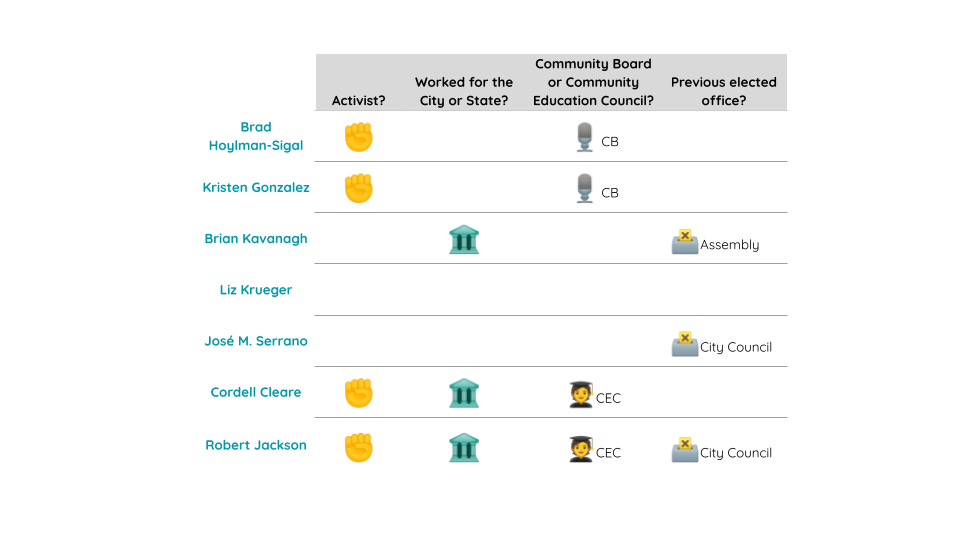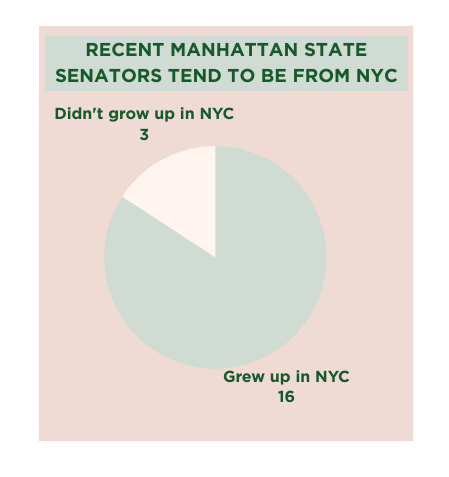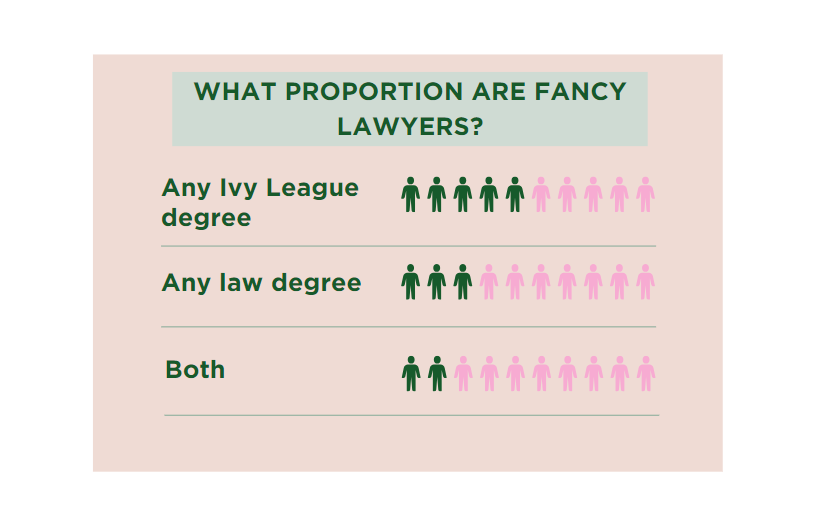What do state senators do again?
State senators make up one “house” in the State Legislature– the Assembly is the other “house.” Together, both houses and the Executive branch (the governor) make laws and approve the state budget. State-level leaders have a huge impact on New York City residents’ day-to-day lives. They’re allocating a huge budget (New York state’s FY 2024 budget is $229 billion), which means making value judgments on where those dollars should be spent. And they’re passing policy on not only statewide stuff like minimum wage, but also things that just affect New York City: from housing density to the number of charter schools.
There are 63 State Senators total, each representing their chunk of the state of New York. There are 7 state senate districts in Manhattan and some of them cross over into other boroughs.

A couple base requirements to become a New York State Senator:
Each member of the Legislature must be:
a United States citizen,
a resident of the State for five years and,
a resident of the Senate or Assembly district for one year preceding the election.
But how do you get elected?
1. Get some experience representing your community.
This doesn’t mean you have to run for City Council or quit your day job.
It’s pretty common to start by serving on a Community Board (CB) or Community Education Council (CEC). Of our 7 current state senators, 2 served on their CBs and 2 served on their CECs. All CEC and CB members are volunteer representatives– no pay.
CEC members are basically NYC’s version of local School Boards, and weigh in on issues affecting district schools. CEC representatives provide input on proposals from the local agency that runs the public schools: NYC Department of Education. CEC representatives hold town hall meetings with the NYC Schools Chancellor, which basically means they’re elevating the concerns and perspectives of the community to the CEO of the district. CEC members can either be elected or appointed, but only parents of NYC public school kids or students themselves can vote for their CEC. So it’s not on the primary or general election ballot.
On the other hand, CB members weigh in on issues affecting neighborhoods. For example, my CB weighs in on where new legal cannabis stores can be approved and whether changes can be made to historic buildings. CB meetings are forums for public input, so members hear and process residents’ concerns about everything from crime to noise and traffic. CB members aren’t elected. They are appointed by the Borough President– for my CB, I applied by filling out an online form, there was an interview process, and then I got an email saying I was selected.
See the below table of how today’s state senators built experience representing their communities:
2. Get deep experience in a particular issue area.
Serving on your CEC or CB will give you deep experience in the particular issues in your community– and there are other ways to build that experience as well. In looking at the bios of current Manhattan State Senators, I noticed that many had backgrounds in community activism or had direct experience working for an agency or elected official. For example, Cordell Cleare was a tenant organizer and then the Chair of the New York City Coalition to End Lead Poisoning. Brian Kavanagh was an aide to former NYC Mayors Ed Koch and David Dinkins and chief of staff to City Council member Gale Brewer. For both Cleare and Kavanagh, they not only built experience in city and state policy, they also built strong relationships with electeds and community members that are important for running for State Senator.
When running for State Senator, you need a track record of success to point to. Successes in community activism, public sector projects, or accomplishments from serving on a local body can all provide good sound bytes.
3. Identity also matters.
Race, religion, and sexual orientation are important markers that let voters know that representatives understand their issues and community firsthand. Here’s just a few examples:
State senators representing Manhattan’s West Side for the last 25 years have identified as gay. Tom Duane, the first openly gay member of the New York State Senate, was elected in 1998 to serve the senatorial district along Manhattan’s West side, which includes Chelsea and Hell’s Kitchen. His successor, and current state senator, Brad Hoylman-Sigal, identifies as gay as well as Jewish (the district stretches up to the Upper West Side).
Harlem has been represented in the state senate by a Black legislator since at least 1966. I went back eight state senators, which was as far as I could get before I got confused about how the district lines were drawn. It’s not as easy as you might think to find archival state senate district maps online.🤷
East Harlem, also known as Spanish Harlem, has had Puerto Rican state senators for the last 45 years. José Serrano has served the district for 19 years, and Olga Méndez for 26 years before that. Which makes sense since Hispanics have been the area’s largest ethnic group for many decades.
I was also surprised by the high proportion of current Manhattan state senators that grew up in New York City (6 out of 7), so I traced back three “generations” of the politicians that have represented Manhattan’s State Senate districts to get a bit more data. Of the 19 state senators that I looked at, only 3 grew up outside of the five boroughs.
4. An Ivy League law degree doesn’t hurt.
For some reason, I assumed most politicians had fancy law degrees. Of the 19 state senators that I looked at, 10 had any Ivy League degree (53%) and 5 had any law degree (26%). Four (21%) had both. That’s a lot of lawyers, but not the majority. So you don’t have to pass the bar to run for State Senate😄






